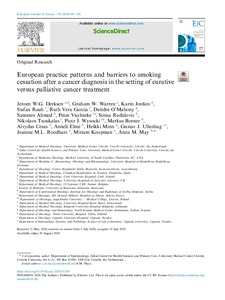European practice patterns and barriers to smoking cessation after a cancer diagnosis in the setting of curative versus palliative cancer treatment
Jeroen W.G. Derksen; Graham W. Warren; Karin Jordan; Stefan Rauh; Ruth Vera Garcıa; Deirdre O’Mahony; Samreen Ahmed; Peter Vuylsteke; Sinisa Radulovic; Nikolaos Tsoukalas; Piotr J. Wysocki; Markus Borner; Alvydas Cesas; Anneli Elme; Heikki Minn; Gustav J. Ullenhag; Jeanine M.L. Roodhart; Miriam Koopman; Anne M. May
European practice patterns and barriers to smoking cessation after a cancer diagnosis in the setting of curative versus palliative cancer treatment
Jeroen W.G. Derksen
Graham W. Warren
Karin Jordan
Stefan Rauh
Ruth Vera Garcıa
Deirdre O’Mahony
Samreen Ahmed
Peter Vuylsteke
Sinisa Radulovic
Nikolaos Tsoukalas
Piotr J. Wysocki
Markus Borner
Alvydas Cesas
Anneli Elme
Heikki Minn
Gustav J. Ullenhag
Jeanine M.L. Roodhart
Miriam Koopman
Anne M. May
ELSEVIER SCI LTD
Julkaisun pysyvä osoite on:
https://urn.fi/URN:NBN:fi-fe2021042827217
https://urn.fi/URN:NBN:fi-fe2021042827217
Tiivistelmä
Background: Smoking cessation after a cancer diagnosis is associated with improved overall survival. Few studies have reported oncologists' cessation practice patterns, but differences between the curative and palliative settings have not been described. We aimed to study the oncologist's perceptions on patients' tobacco use, current practices and barriers to providing smoking cessation support, while distinguishing between treatment with curative (C) and palliative (P) intent.
Methods: In 2019, an online 34-item survey was sent to approximately 6235 oncologists from 16 European countries. Responses were descriptively reported and compared by treatment setting.
Results: Responses from 544 oncologists were included. Oncologists appeared to favour addressing tobacco in the curative setting more than in the palliative setting. Oncologists believe that continued smoking impacts treatment outcomes (C: 94%, P: 74%) and that cessation support should be standard cancer care (C: 95%, P: 63%). Most routinely assess tobacco use (C: 93%, P: 78%) and advise patients to stop using tobacco (C: 88%, P: 54%), but only 24% (P) -39% (C) routinely discuss medication options, and only 18% (P)-31% (C) provide cessation support. Hesitation to remove a pleasurable habit (C: 13%, P: 43%) and disbelieve on smoking affecting outcomes (C: 3%, P: 14%) were disparate barriers between the curative and palliative settings (p < 0.001), but dominant barriers of time, resources, education and patient resistance were similar between settings.
Conclusion: Oncologists appear to favour addressing tobacco use more in the curative setting; however, they discuss medication options and/or provide cessation support in a minority of cases. All patients who report current smoking should have access to evidence-based smoking cessation support, also patients treated with palliative intent given their increasing survival.
Kokoelmat
- Rinnakkaistallenteet [27094]
